PS/SPS User Meeting
Minutes of Meeting
The template for the minutes of meeting for the weekly PS & SPS users meeting can always be found using this link: https://codimd.web.cern.ch/0aHs5uqmSPuII76-SaaQdg
Please pre-fill them before the meeting with a summery of your activities!
PS-SPS Users Meeting for Week 29 held on July 18th, 2024
-
Wednesday September 4th: User meeting exceptionally on zoom only for availability of the conference room (thursday September 5th is CERN holiday).
-
Updated user schedule v3.0.0.. It is based on the updated injector schedule.
-
Please get in contact, if you want to take one of the weeks without assigned main user - Tanja (tetiana.shulha@cern.ch) is collecting all requests.
-
Exchange Magnet H2 beamline: planned for 30.7.-1.8.2024:
No Beam to North Area from Tuesday morning until (expected) Thursday afternoon/evening. -
Upcomming SPS NA target intensity changes: https://codimd.web.cern.ch/grQs-qbsQDa0rwMZbdmc2A
-
Dedicated SPS MDs - if not anounced differently - are taking place from 8:00 to 18:00
News from the PS & SPS Physics Coordinator
E.B. Holzer, M.R. Jäkel
- 2024 injector schedule released EDMS 2872566
2024 approved LHC schedule EDMS 2872429
Proton Run 2024
- AD/ELENA Physics Stop Monday 02.12.2024
- SPS NA Physics Stop protons Thursday 31.10.2024
- PS EA Physics Stop protons Wednesday 27.11.2024
Ion Run 2024
- SPS NA Physics Start 4.11.2024 (maybe earlier if set-up is fast) - Stop Pb ions Monday 2.12.2024 (6h)
- NA : Week 45-47 high energy
- NA : Week 48 low energy (no LHC running)
- PS EA Physics Start 6.11.2024 (tbd) - Stop Pb ions Monday 2.12.2024 (6h)
- CHIMERA: 13.11-2.12
Ion run Coordination Meeting : Tuesday 23.7. at 16h
Reminder: Beam time exceeding the limits of 2 weeks PS beam time and 1 week SPS beam time per year need the approval of one of these CERN committees: SPSC, LHCC, DRDC, INTC, RB or IEFC. Consider joining a DRD collaboration, if you require more beam time.
News from the Facilities Operations Meeting (FOM) (E.B. Holzer)
Target intensities:
- Change to T4 standard wobbling and 100 mm target head on Wed. 17.07., then also back to the standard 42 units on T4.
- 150 units on T6 on the morning of Friday 19.07. for M2 high-intensity RP test
Upcoming SPS MDs next weeks :
https://be-dep-ea.web.cern.ch/content/md-planning-north-area
Dedicated SPS MDs - if not anounced differently - are taking place from 8:00 to 18:00
- W29 Dedicated: 17.7 → extraction MD (octupole assisted extraction TT20 MD | 50Hz noise studies in parallel in the morning | BE-EA measurements/tests in P42 in the afternoon)
- From 14:00 onwards NO access in BA80, BA81, and TCC8-ECN3 (see also information distributed via dedicated mailing list)
- W30 Dedicated: 24.7 → octupole assisted extraction TT20 | potentially BE-EA measurements/tests in P42
- Probably similat=r sharing with access / NO access to ECN3 as in week 29. Details to be defined.
- W31 Dedicated : 30.7 to 1.8 (shadow of magnet exchange)
- Dedicated: 30/7 → phase space manipulation with sextupoles & octupoles
- Dedicated: 31/7 → COLDEX
- Dedicated: 1/8 → vertical instabilities with LHC beam | PC noise
PS Machine Report (B. Mikulec)
- Thu-Thu availability 87.1%; four main problems:
- Electrical glitch Friday evening; bending in EAST transfer line required piquet intervention
- 2.5h downtime due to Booster injection kicker issue (R3) Saturday evening
- Monday early afternoon 18 kV trip early afternoon due to emergency button destroyed in b358 during a handling accident while dismantling the old PS rotating machine
- Multiple piquet and specialist interventions.
- First beams back around 20h (TOF, LHCINDIV), followed by AD and SFTPRO
- EAST_T8 beam back around 23h, T9/T10 only early Tuesday morning (cooling problem)
- 1.5h beam stop Wednesday morning for C10-46 amplifier exchange
- Additional points:
- Losses reduced for EAST beam extraction
- PSB-to-PS energy matching and trajectories updated for all beams
- Cycle checked for SFTPRO intensity increase tomorrow
- New optics adjustment to be scheduled (Yann) before using BIG parasitic TOF bunch on EAST
SPS Machine Report (C. Zannini)
- Th-Th availability 72.5%
- Burnt Cavity 3 HOM coupler (~24h)
- Issue with 18kV distribution in Meyrin (~8h)
- AWAKE
- Beam delivered according to request
- SFTPRO
- High intensity SFTPRO MD on Monday did not take place
- Dedicated MD on Wednesday on optimization of slow extraction with octupoles
- Intensity adjustment (sharing 30/42/30 on T2/T4/T6)
- As requested intensity will be increased to 150 units on T6 on Friday early morning.
- Intensity on T6 will be reduced to minimum after the studies on Friday
Safety (A. Schouten)
- General reminder for ISIEC requests next week.
nToF (M.Bacak and P.M.Milazzo)
Smooth data taking in all experimental areas.
Beam in standard conditions.
EAR1: start of the 63Cu(n, g) measurement
EAR2: start of the Ar(n, g) measurement (several gas pressure will be used)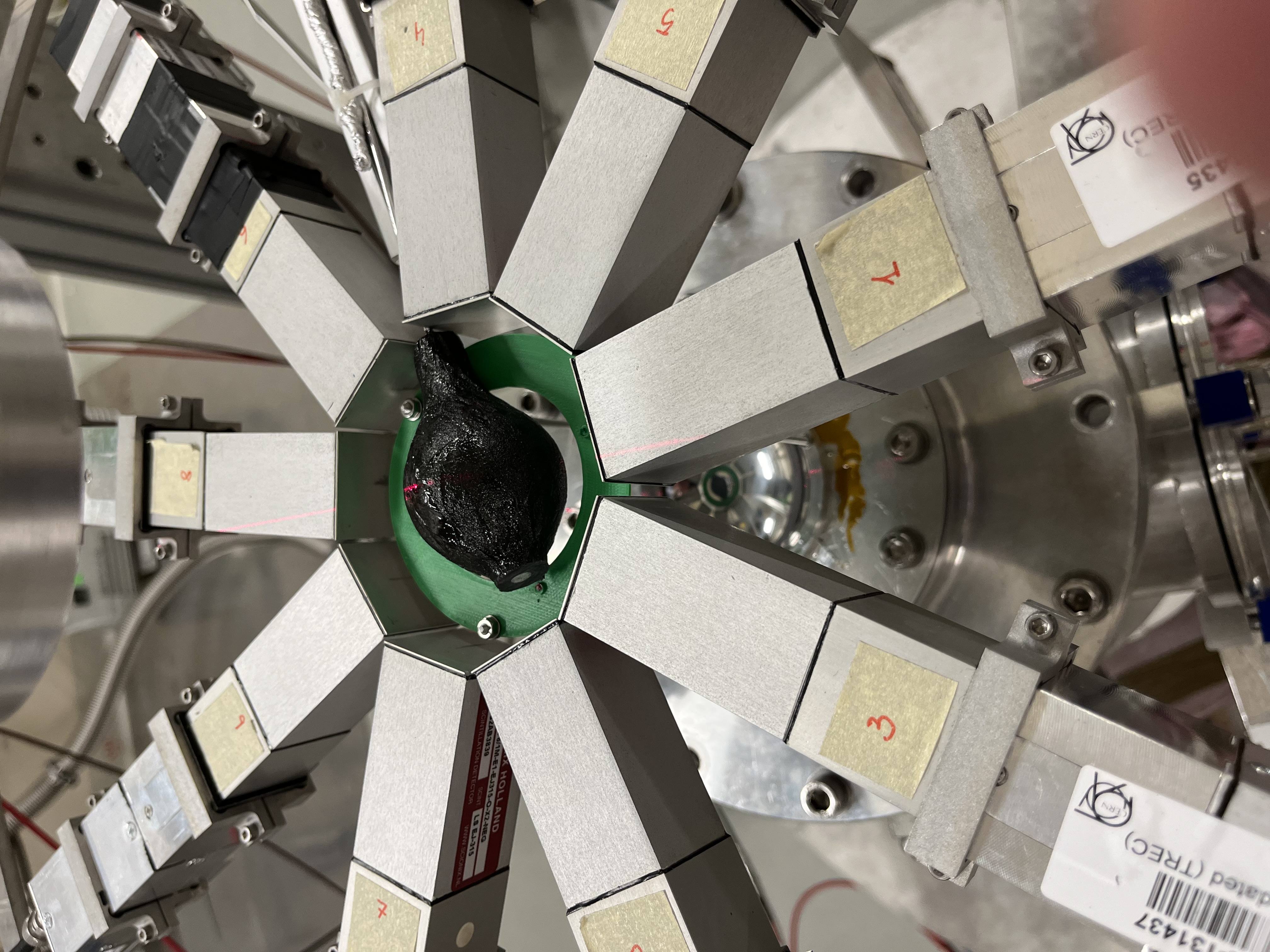
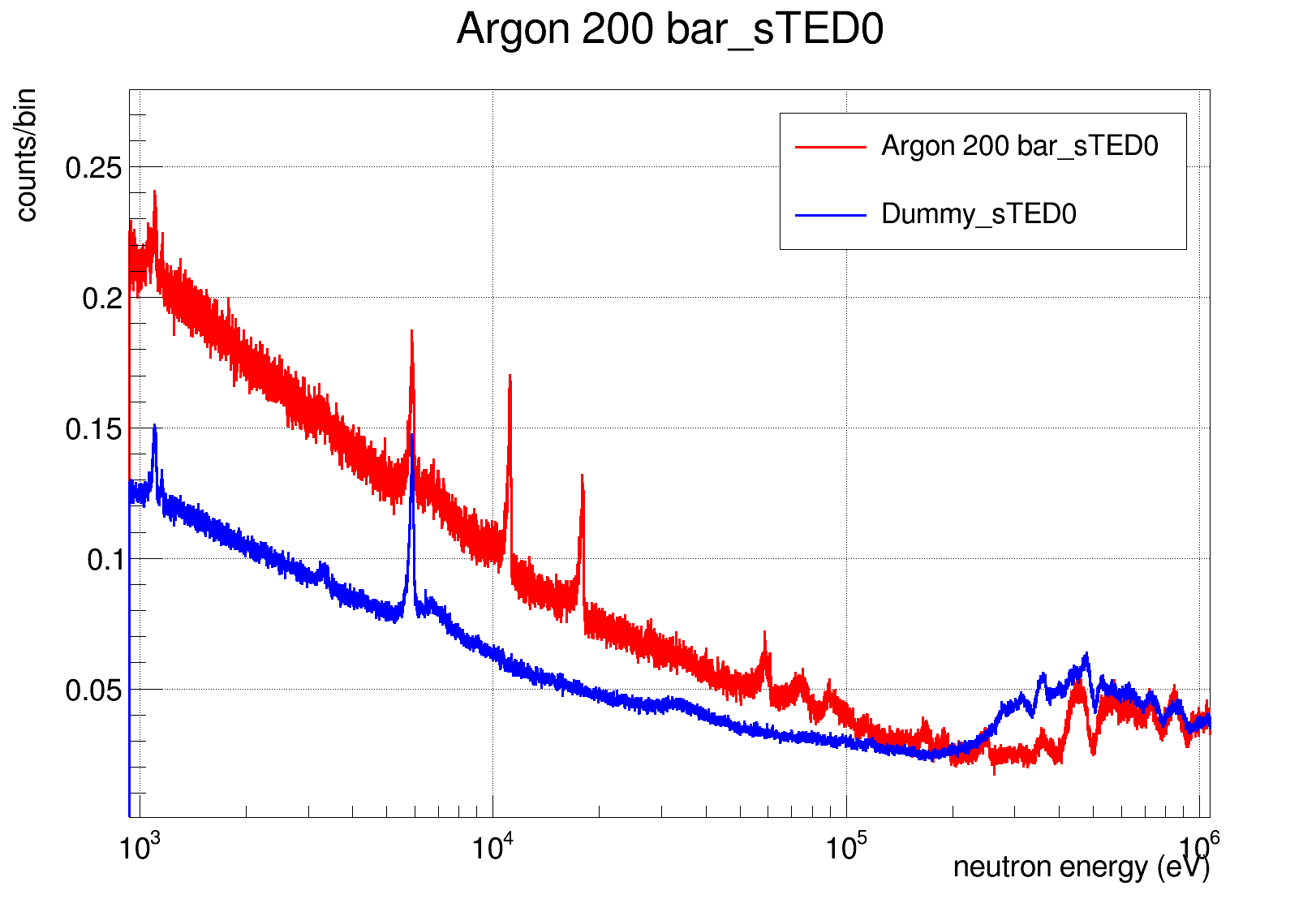
NEAR: activation measurements
East Area Beam Status (B. Rae)
On call number: 67500
General : AUG incident, problem with cooling water at the restart that delayed starting the T09/T10 beams until the middle of Monday night.
T09: No issues. WCTE assembly also ongoing in B157 so a big area is currently occupied in the hall.
T10: Good operation.
T11: No user.
East Area Users Tour de Table
T8 Main: IRRAD/CHARM (F. Ravotti)
Inspite mentioned issues, good week: cumulated ~2.6E16 p/w and a TID of ~500 Gy as required by the current users in the CHARM area.
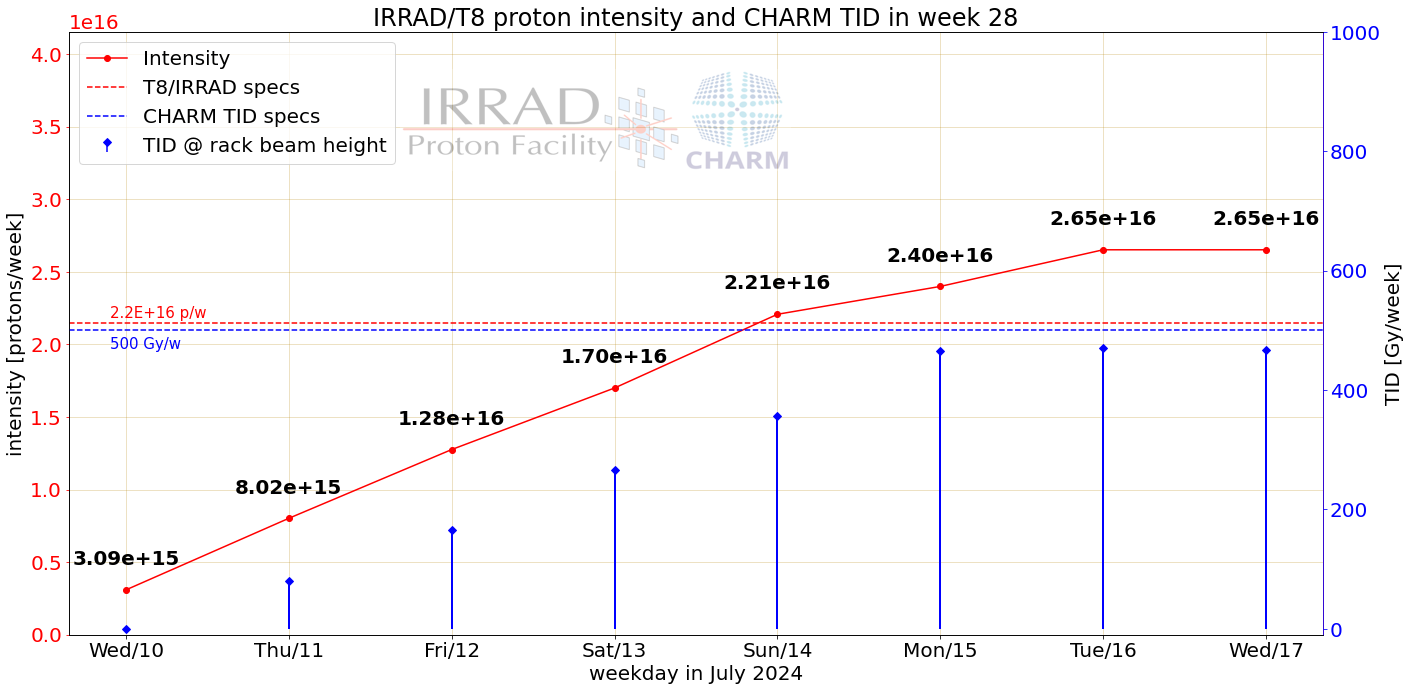
Beam less “stable” than the previous week, both about the delivered intensity (“slow" drift, see below) and beam centering (~90% of spills are centered on X-axis, w.r.t 95-96% during previous week). Moreover, issues appeared with combined cycles TOF/EAST when TOF does not take beam (see also below, period from 14:00 to 15:00)
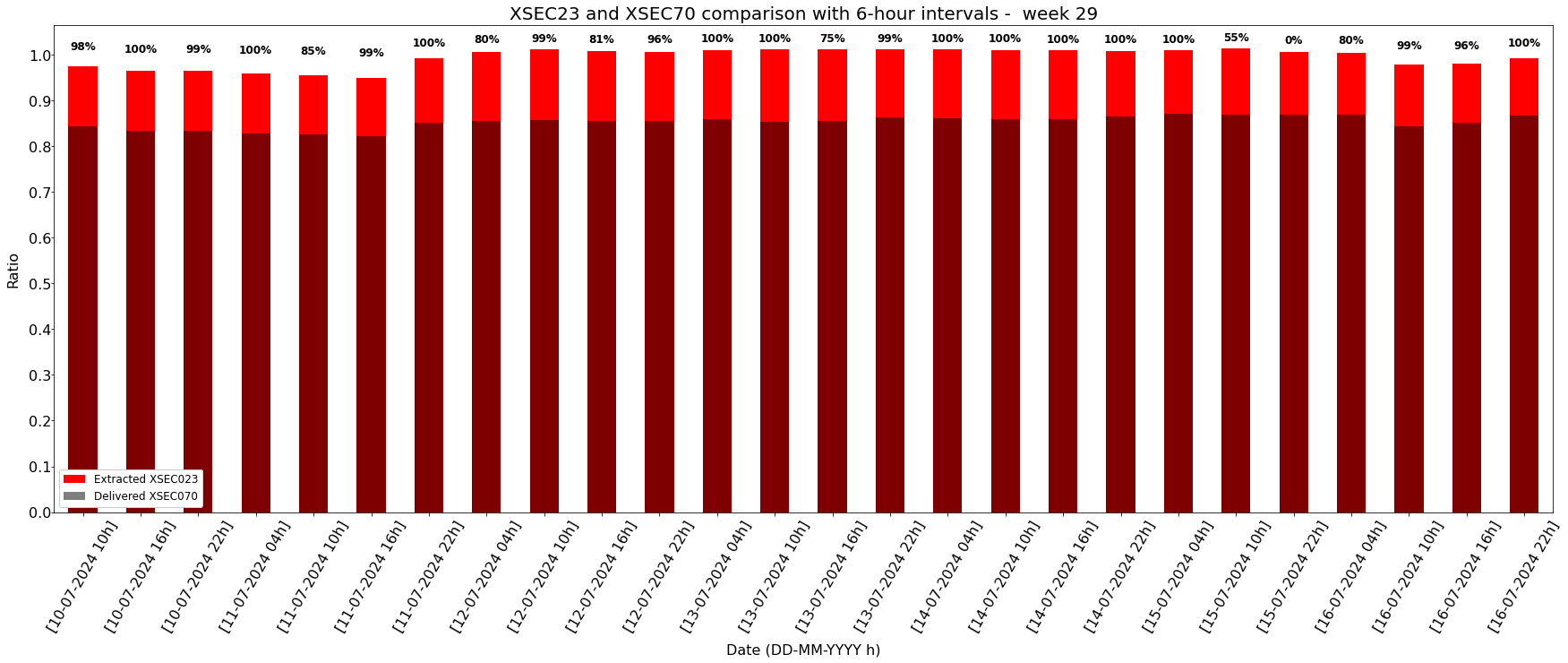

During the access on Wednesday: (1) In CHARM we exchanged experiment for SY-EPC, installed one ATLAS user (ADC board) while the CMS-RPC setup continue. (2) In IRRAD we completed CMS MTD ETL and installed cold irradiation experiment for ATLAS iTk strip modules, while all other long-term experiments continue.
We continue until next Wednesday with the extracted standard high-intensity (8oE10 pps).
(F.R. is away for next couple of weeks - replacement will attend or send information before the meeting)
T9 Main: DRD MPGDCAL (Luigi Longo)
- Data taking runs smoothly with no problems
- Already completed the X&Y scan
- On going energy scan for pion shower studies but we have just asked for 3 spills per cycle (daq is quite slow and we would need more stats)
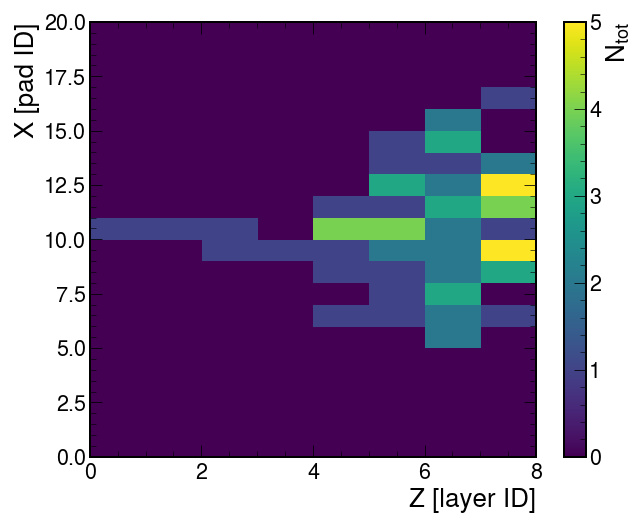
T9 Incoming Main: CMS BRIL (Week 30) (Olena Karacheban)
Testing similar setup to what we have done in April. New sensor type: 6-pad silicon sensors for Phase-2 CMS luminometer.
Beam profile files: oval beam X 18 mm, Y 3 mm.
Short spill file is available from the last test beam: 100 us. It will be used 1 or 2 times. For the rest on the time we will use normal 400 us spills.
Setup: telescope on the DESY-table, our detector cold box about 30 x 30 cm between telescope planes. Behind the last telescope plane slall XY-table with inner tracker pixel module and scintilator.
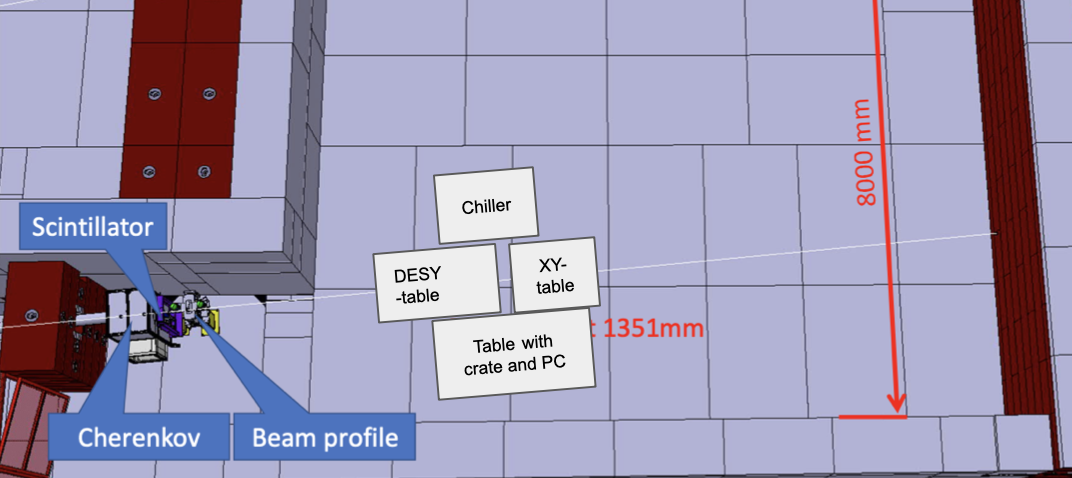
What time can we expect to start setting up on Wednesday?
Safety check is expected on Wednesday at 16:00. Safity
T10 Outgoing Main: IDEA CC (Nicola De Filippis)
We completed our tunings of the setup and reached a stable configuration yesterday. We are running smoothly with a 10GeV beam, 90%/10% He/Isob. gas mixture and will continue in the next few days with different momentum and mixtures, without too many interruptions. Data are stored at CERN and analyzed almost in real time. We kindly ask the beam manager to provide us the largest number of spill per minute and a beam as continuous as possible.
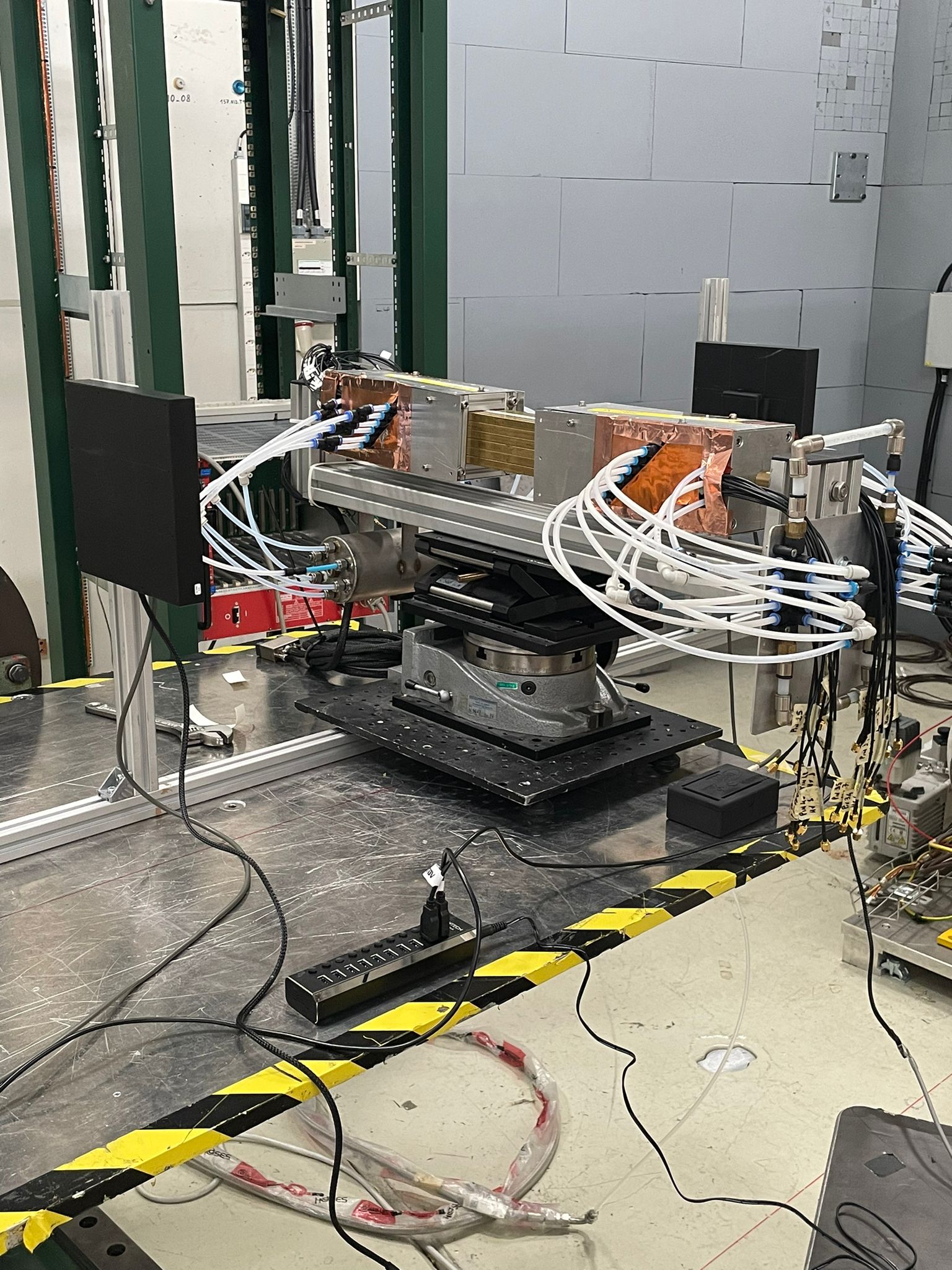
T10 Incoming Main: BL4S (Week 30) (S. Zoechling)
Beamline for Schools (BL4S) is an outreach program for teams of high school students. Teams propose ideas for an experiment in a beamline, 2 winning teams receive an invitation to conduct their experiment at CERN. This year: testing homemade muon detectors
Goals of the testbeam:
Goal 1: Verify measurement principle of both teams, verify relationship between peak amplitude & deposited energy in scintillators
Goal 2: Establish and optimize alignment and xy tracker calibration procedure for Sakura particle team
Goal 3: Estimate data rate & inter-trigger time distribution to avoid issues with rate-limited electronic frontends of both teams
Goal 4: Tune beam and optics parameter to prepare for later test beam in September (W37 and 38)
Stretch Goal 5: If time allows, test and document possibility of using a WENDI detector for spallation experiments in future BL4S editions
Setup:
Goals 1-4
Stretch Goal 5
Safety check is expected on Thursday at 9:00.
Many thanks for all your support and help, BL4S would not be possible without it!
Outlook: Testbeam in September (Weeks 37 & 38) during the visit of the two winning teams @ CERN
North Area Beam Status (B. Rae)
On call number: 67500
Target Intensities for this week :
| T2 | T4 | T10 | T6 |
|---|---|---|---|
| 30 | 20 → 42/52 (pending decision on target head) | 20 | 30 |
General: Change of T4 target from 500mm to 100mm on Wednesday and now positive particles to H6/H8. Positron rate in H6/H8 would benefit from going to a 180 mm target head today.
H2: Smooth operation (beamline limited to 150 GeV/c).
H4: Smooth operation. XCET.022176 repaired.
H6: Access door issue in PPE146 where the door would not lock. Second issue where it would not open. First issue caused about 2 hours interruption. Second issue was fixed during Wednesday setup. Otherwise, generally good operation.
H8: Good operation. The requested 20 GeV/c beam was far away from the wobbling settings at negative 300 GeV/c, thus the rate was on the lower side. Better now with the standard wobbling settings.
P42/K12: Finished special low-intensity run for NA62, now back to 20 units on T10. For August 2nd, a high intensity beam dump is requested by NA62, which will require going to about 75-85 units on T4 to reach 55 units on T10.
M2: No issues. End of AMBER APX run. Installation of NA64mu ongoing. A high intensity muon test together with RP (2E8 µ/spill) planned for Friday between 08:00 and 12:00. No access in EHN2 during this period and 150 units on T6.
AWAKE (M. Bergamaschi)
| Week 28 | M | T | W | Th | F | S | S |
|---|---|---|---|---|---|---|---|
| SPS extractions to AWAKE | 140 | 234 | e- beam | MD | 34 | 1155 | 396 |
| Hours of beam to AWAKE | 1.3 | 2.2 | e- beam | MD | 0.4 | 6.9 | 2.6 |
Detailed program Week 28:
- Monday: Morning access for a problem with electron modulator. Diagnostics checks, test of new upgrade of vapor source
- Tuesday: Start of plasma studies, interrupted by a failure of one component of plasma source
- Wednesday: electron beam studies
- Thursday: Access with repair of heater of plasma source and ebeam klystron maintenance
- Friday: Cavity repair and mains issues on SPS, limited beamtime to AWAKE
- Saturday: Effective studies of acceleration in plasma at low density
- Sunday: Studies of acceleration in plasma interrupted by power glitch on plasma source chillers power line, access to repair the faulty power supply
| Week 29 (so far) | M | T | W | Th |
|---|---|---|---|---|
| SPS extractions to AWAKE | 240 | 1102 | MD | MD |
| Hours of beam to AWAKE | 1.9 | 8.4 | MD | MD |
Detailed program Week 29:
- Monday: Plasma acccelration studies interupted in the afternoon for problems in the injectors
- Tuesday: Plasma acccelration studies, very effect day
- Wednesday: MD, Access for maintence of laser
- Thursday: MD
North Area Users Tour de Table
P42-K12:
Main: NA62 (Jurgen Engelfried)
- NA62 finished its low intensity data taking of one week yesterday. The main goal for this is to have minimal systematics to extract Vus, and to address the (non)-unitarity of the first row of the CKM matrix. A first rough look at the data looks very promising. We are greatfull for all the support we received from all involved from the machine side, but also from our “neighbors” to approve this special intensity setting.
- After the MD we switched back to normal intensity data taking. We noticed an improvement in the beam quality, in particular the 50Hz component, and appreciate the efforts by the beams group.
- We would like to ask for a shift of the approved high intensity running in dump mode, originally forseen for 10 days starting on July 29, to start now on August 2, after the 3-day stop for the magnet exchange; it should still last for 10 days.
M2:
Outgoing Main: AMBER (Thomas Poschl)
- finished data taking of antiproton production in proton-hydrogen and proton-deuterium collisions
- have set spectrometer to “winter mode” yesterday
- despite delays, managed to complete measurement plan (hydrogen and deuterium measurements at 80 GeV/c, 160 GeV/c, and 250 GeV/c + calibration measurements
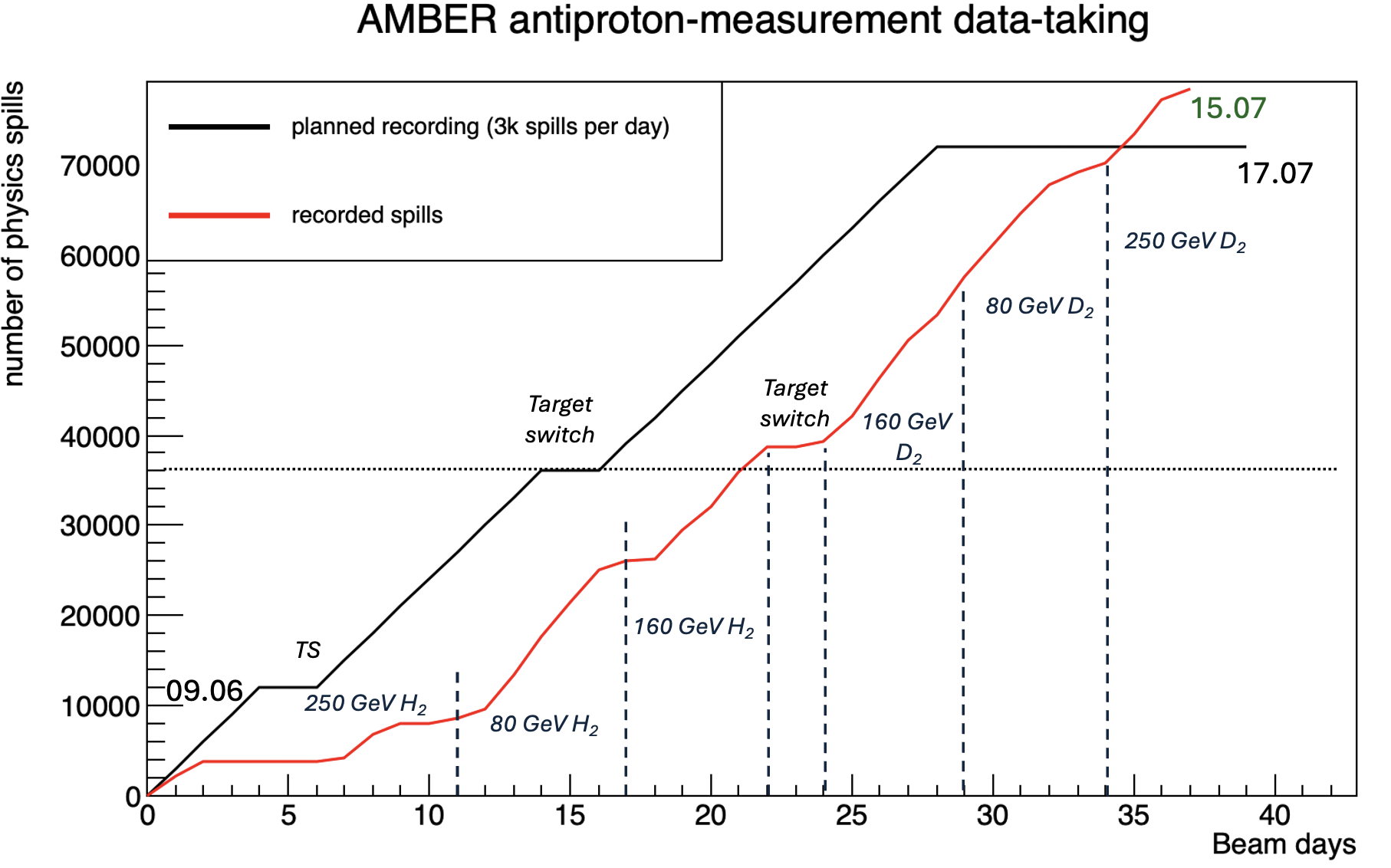
- We would like to thank all involved CERN services who supported the AMBER beam time and allowed us to succeed the data taking (BE,EP,EN,TE,SY, and HSE)
- special gratitude to Johannes Bernhard, Dipanwita Banerjee, and our SPS User coordinators for all the effort from their side!
- Will be back on 07 October for high-intensity DY test and PRM test
Main: NA64mu (Week 30) (Vladimir Poliakov)
The dismounting of AMBER equipment is in progress. The installation of two MBPL magnets and NA64 calorimeters should be started afternoon. We will continue the installation of calorimeters, tracking detectors, veto and beam counters during the next week until Friday July 26.
H2:
Main: NA61 SHINE (P. Podlaski, B. Maksiak)
- started physics running on Saturday
- stable running when the beam is present
- intervention on VTPC electronics cooling by EN-CV during the dedicated MD yesterday
- please close the big transport door on Jura and Saleve sides of EHN1 - increases in humidity are not good for our detectors
- is it possible to make MD announcements on SPS Page-1 more clear?
- some beam posotion drift/jumps are still observed
Incoming No beam: CMS HGCAL (D. Lazic)
- See slides attached to the agenda
H4:
Main: NP04 (Christos Touramanis)
This is our 1/2 consequtive beam weeks.
Smooth data taking with beam on; systems development and tests outside beam: mainly DAQ, Photon Detector System.
Taking data at 1 GeV for pions, alternating polarity every couple of days.
Cherenkovs: Now both beam Cherenkovs (high and low pressure) working well (around 82% efficiency on the pleteau). Important for our physics data taking! Thank you BE coleagues, specially Inaki :)
Positive outlook for long run in August, shifts already filled >90%.
Incoming Main: DRD6 OREO (Week 30) (S. Carsi)
Please, see attached slides on indico
- Test of the first full prototype of an oriented calorimeter based on oriented crystal at higher energies (already test in June in T09)
- We plan to install on Wednesday July 24th
- In the first phaes, we must align and calibrate our detectors
- Then, we can move to the Physics runs and acquire statistics at different energies
H6:
Outgoing Main: MUONE ECAL (Fred Gray)
-
Excellent electron beam quality; delayed start because of SPS cavity vacuum problems.
-
Friday (12/7) - Monday (15/7): Data collected to measure energy and position resolution of current MUonE ECAL prototype. Highlights included an energy scan with a (precisely) 10 mm collimator:
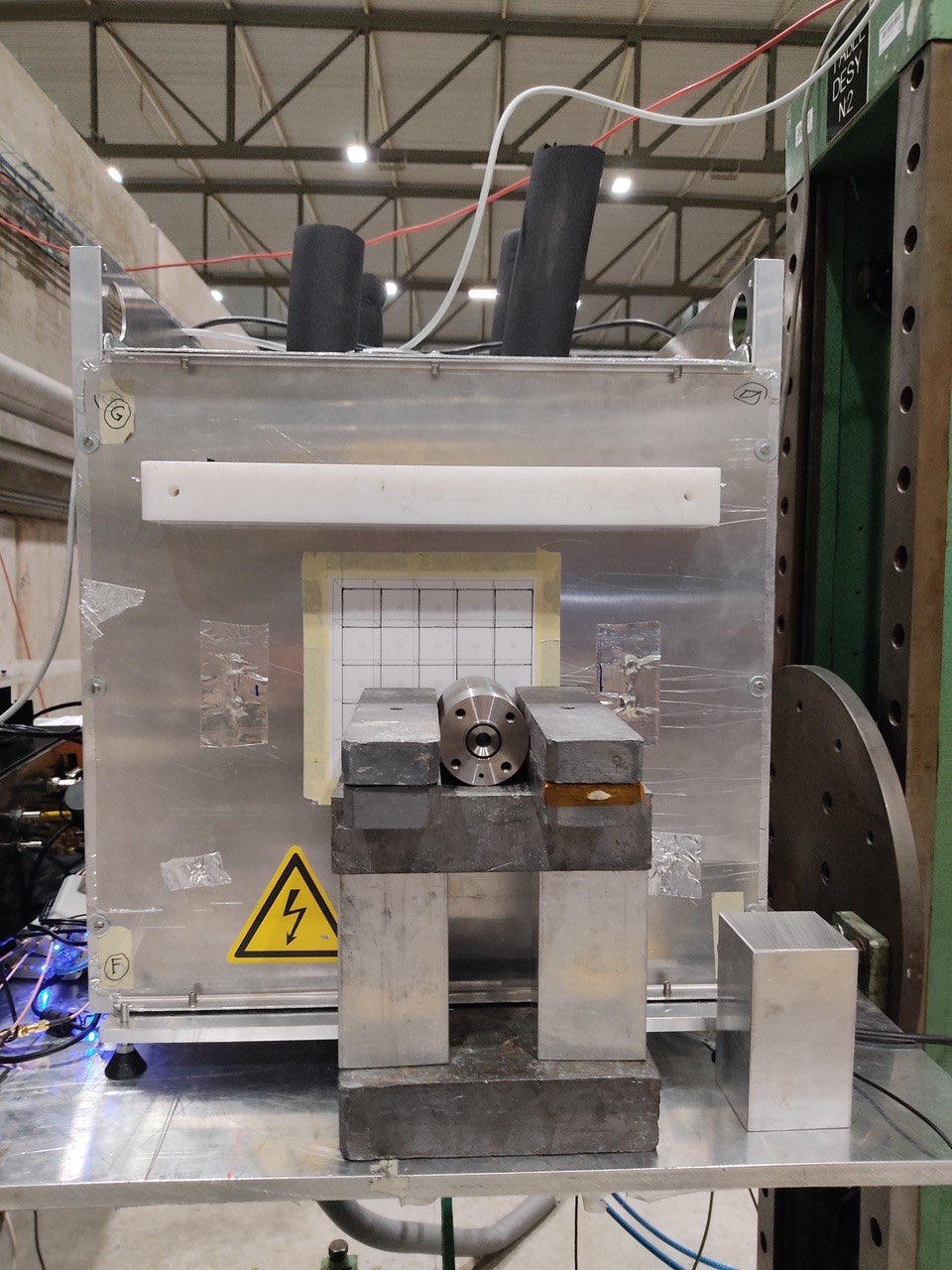
as well as a muon run with an external trigger from a prototype of a muon tracker for MUonE that was placed behind an iron block following our setup. -
Monday (15/7) - Wednesday (17/7): Operation of 5 PbF2 crystals from Muon g-2 experiment at energies up to 100 GeV with usable SiPM signals was demonstrated, with data collected at 100, 50, and 30 GeV.
Main: DRD6 MAXICC (Marco Lucchini)
Installation completed and safety inspection passed. Patrol training done.
Inaki checked the integrity and calibration of the DWC which was not calibrated and show low efficiency in the central region. DWC in H6 just replaced and now filling with gas.
Few runs with muon already taken, will soon move to run to a mixed hadrons beam and later in the day to 10 GeV electrons.
Beam files already prepared and tested yesterday. Thank you to all SPS experts!
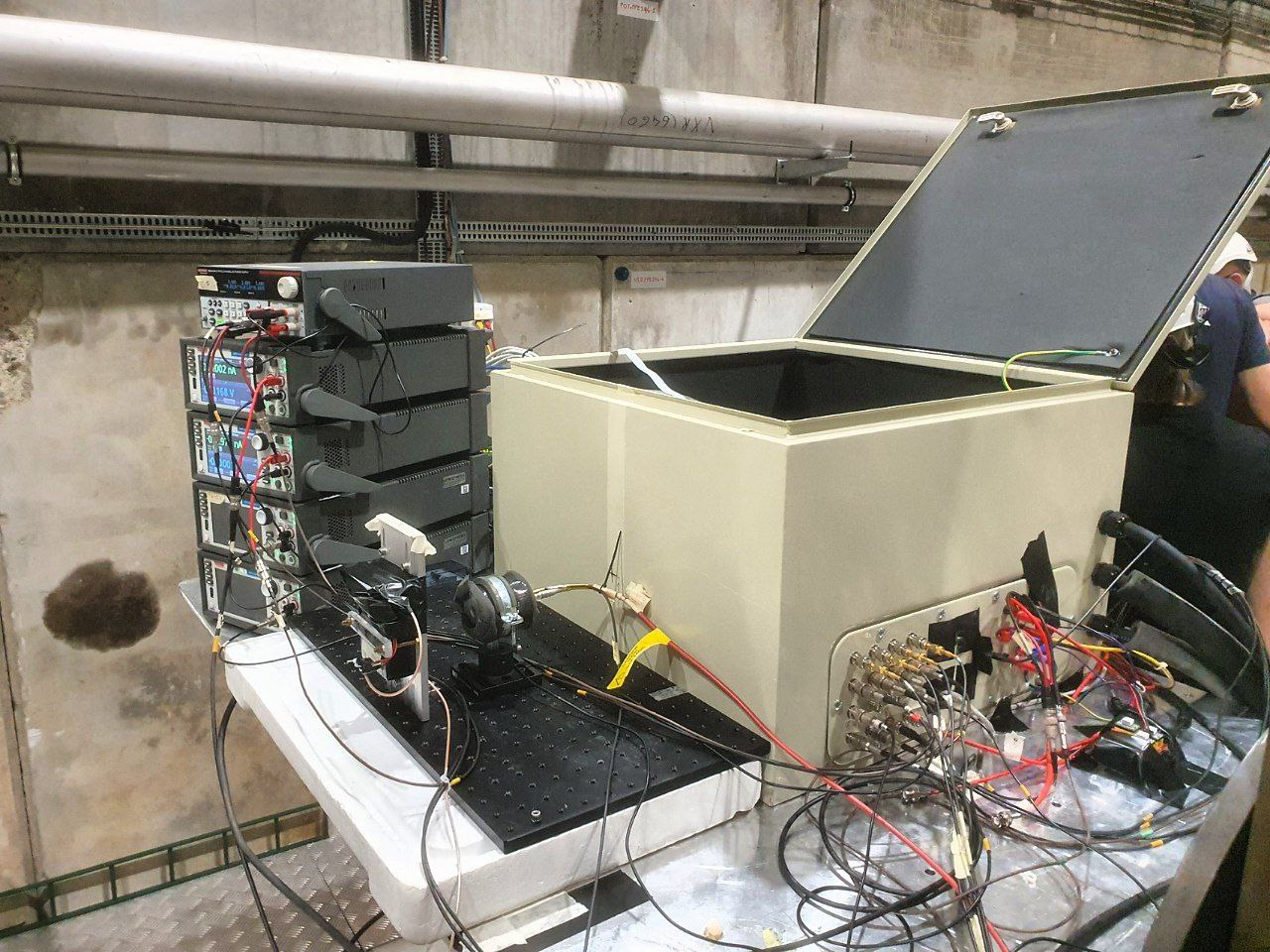
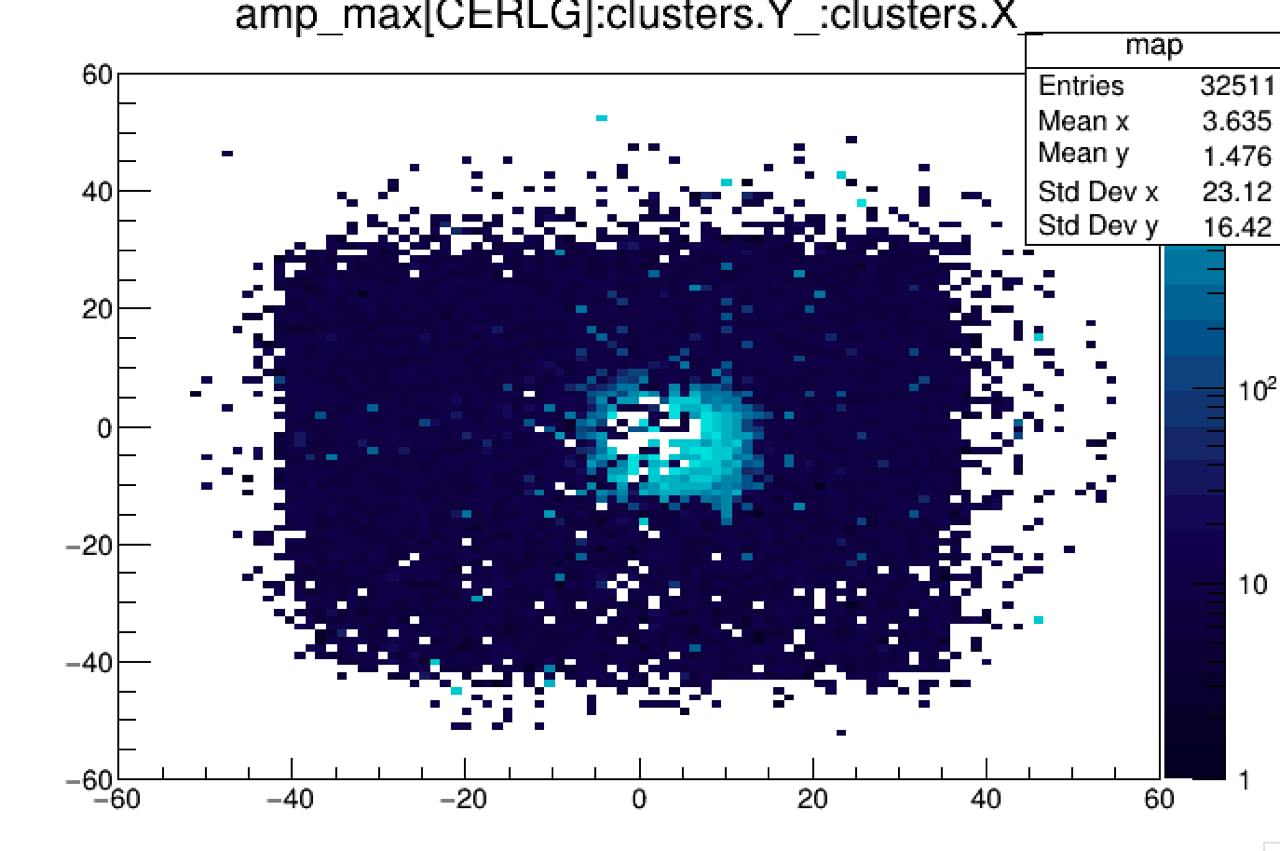
Incoming Main: EP FTS (Week 30) (L. Martinazzoli)
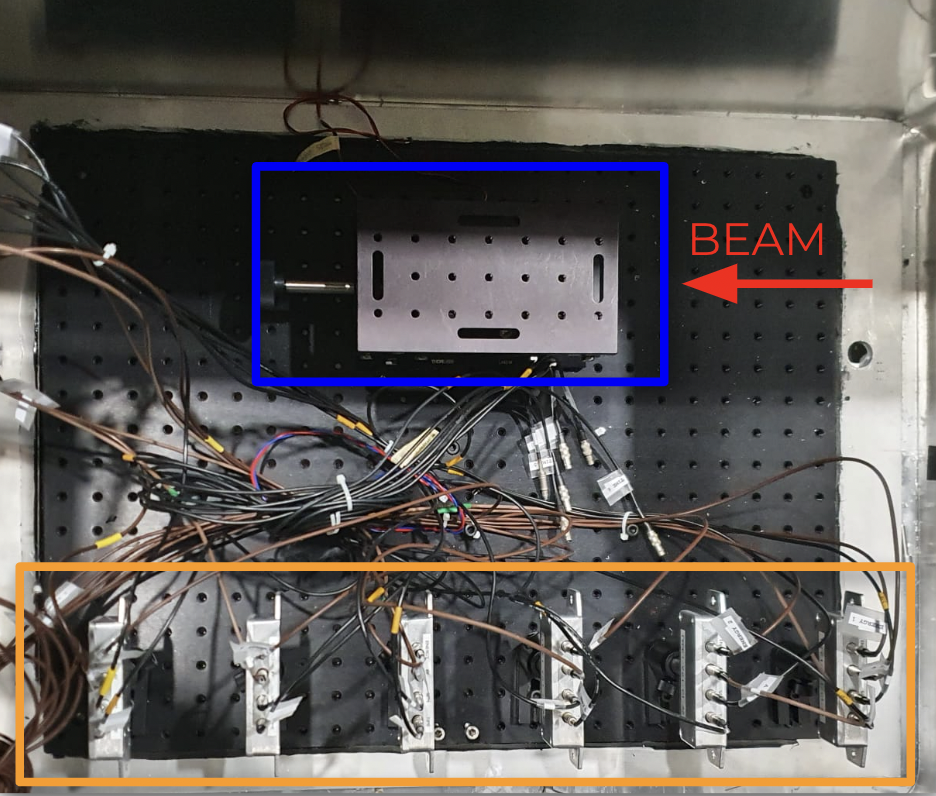
Studies of novel scintillators for fast timing applications
- Box to be installed on a DESY table
- 2 set-ups
- 1 support dedicated to future calorimeters test
- 1 series of SiPM amplifiers for MIP timing layers
Beam configuration:
- Mainly “MIP” beam (pi𝑝𝑖 or mixed hadrons)
- Calorimeter applications
- e−𝑒− a few momenta in 20-100 GeV/c range
- π𝜋 at the highest e−𝑒− momentum for comparison
H8:
Main: MPGD TRD (Julia Velkovska, Yulia Furletova)
MPGD-TRD setup is ready for data taking. Safety inspection is done.
The setup has been aligned along the beam line.
Calibration runs during Wed evening/night
Beam conditions- the same as last week for ATLAS-TRT group ( 20GeV secondary, 75% positrons ).
and also pion/hadron beam ( 20-100 GeV) later this week.
Many thanks to ATLAS-TRT group for their help with the trigger and particle selection!
Incoming Main: ATLAS TRT (Week 30) (Please Put Your Name Here)
Parasitic Users
H6: ATLAS MALTA (Please Put Your Name Here)
H8: STRAW TRACKER RD (Temur Enik, Katerina Kuznetsova)
- safety visit done, setup in operation
- program for next two weeks:
- noise reduction (H4 data-taking follow up)
- low rate data with the combined prototype and stand-alone SHiP tube
AoB
Minutes by the respective speakers, edited by E. B. Holzer, M. Jäkel, T. Shulha, and M. Schwinzerl